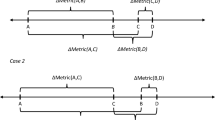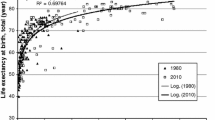Abstract
As an alternative to the “competing mortality risk model”, this paper presents an “independent mortality risk model” in which the complementarity among various longevity investments is less obvious. In studying spillover effects of cause-specific longevity interventions, it distinguishes between two types of such interventions: cause-specific price reductions and cause-specific direct provisions. It finds that a cause-specific direct provision always has a positive spillover effect on longevity investments for other causes, but a cause-specific price reduction may have a negative spillover effect due to a substitution effect.
Similar content being viewed by others
Notes
In this paper, as in other studies on this topic, we assume that mortality risks are uninsurable. Hence, insurance has no role to play in this paper. If one treats these risks as insurable and introduces a market for insurance, moral hazard and adverse/self selection must also be considered in the analysis—a complication not dealt with in the present paper.
Other results coming from the competing mortality risk model include normality of longevity investments and downward-sloping demand for longevity investments. These results can also be obtained in our alternative model. We will focus on the spillover effect in this paper because it is more interesting, and it is an aspect in which our alternative model generates different results. Chang [3] shows that neglecting uncertainty in the Leontief longevity production overstates spillover effects. Nevertheless, the underlying Leontief longevity production process used by Chang [3] inevitably leads to a positive spillover effect from a cause-specific price reduction.
For example, because of a gene defect in many East Asian descendants (up to 50% depending on the specific ethnic group), which causes a difficulty in decomposing a poisonous intermediate product of alcohol consumption, this group of population is more prone to liver cancer associated with drinking alcohol, a phenomenon known as the “Asian Blush.” On the other hand, African Americans are known to have a larger tendency to develop heart diseases, probably due to a genetically higher level of salt retention.
In the real world, there are many causes of mortality. Our two-cause model can be generalized to include multi-cause cases without qualitatively altering the results obtained in the paper.
Probability-reducing investments are called “self-protection”, as opposed to loss-reducing investments, which are called “self-insurance” [6].
For the general state-dependent utility model used in life–death situations, see Jones-Lee [8], Weinstein et al. [17], Pratt and Zeckhauser [14] and Eeckhoudt and Hammitt [5]. Also see Viscusi and Evans [16] and Bleichrodt et al. [2] for applications of the state-dependent utility model to health situations other than life or death, and Neilson [11] for a non-health application.
Note that \(\frac{{\partial F}}{{\partial G_{2}}},\) as well as all other partial derivatives of functions F and Q, is evaluated at the optimal (x 1, x 2), where the first order conditions in Eq. 2 hold. From the definition of \(F, \tfrac{{\partial F}}{{\partial G_{2}}} = \tfrac{{- m_{2}^{\prime} F}} {{1 - m_{2}}},\) which is zero according to the first FOC in Eq. 2.
Note that x 2 is endogenously determined with the specification of not only m 2(·), but also m 1(·) and u(·). The equilibrium value of x 2 also depends on parameters such as p 1 and p 2. However, with appropriate specifications of m 1(·) and u(·) and “right” parameter values for p 1 and p 2, it is possible to have Ax 2 > 1 + AG 2.
Focusing on a single mortality cause, Liu and Neilson [10] explain the implication of substitutability/complementarity between public and private safety efforts for the issue of how the willingness to pay for a mortality risk reduction changes with the base level of mortality risk.
References
Bleichrodt, H., Quiggin, J.: Life-cycle preferences over consumption and health: when is cost-effectiveness analysis equivalent to cost-benefit analysis? J Health Econ 18, 681–708 (1999)
Bleichrodt, H., Crainich, D., Eeckhoudt, L.: Comorbidities and the willingness to pay for health improvements. J Public Econ 87, 2399–2406 (2003)
Chang, F.-R.: A theory of health investment under competing mortality risks. J Health Econ 24, 449–463 (2005)
Dow, W.H., Philipson, T., Salai-Martin, X.: Longevity complementarities under competing risks. Am Econ Rev 89, 1358–1371 (1999)
Eeckhoudt, L.R., Hammitt, J.K.: Background risks and the value of a statistical life. J Risk Uncertain 23, 261–279 (2001)
Ehrlich, I., Becker, G.: Market insurance and self-insurance. J Polit Econ 80, 623–648 (1972)
Ganz, M.L.: The relationship between external threats and smoking in Central Harlem. Am J Public Health 90, 367–371 (2000)
Jones-Lee, M.: The value of changes in the probability of death or injury. J Polit Econ 82, 835–849 (1974)
Keeler, T.E.: Highway safety, economic behavior, and driving environment. Am Econ Rev 84, 684–693 (1994)
Liu, L., Neilson, W.S.: Endogenous private safety investment and the willingness to pay for mortality risk reductions. Eur Econ Rev 50, 2063–2074 (2006)
Neilson, W.S.: Optimal punishment schemes with state-dependent preferences. Econ Inq 36, 266–71 (1998)
Peltzman, S.: The effects of automobile safety regulation. J Polit Econ 83, 677–725 (1975)
Peterson, S., Hoffer, G., Millner, E.: Are drivers of air-bag-equipped cars more aggressive: a test of the offsetting behavior hypothesis. J Law Econ 38, 251–264 (1995)
Pratt, J.W., Zeckhauser, R.J.: Willingness to pay and the distribution of risk and wealth. J Polit Econ 104, 747–763 (1996)
Sen, A.: An empirical test of the offset hypothesis. J Law Econ 44(2), 481–510 (2001)
Viscusi, W.K., Evans, W.N.: Utility functions that depend on health status: estimates and economic implications. Am Econ Rev 80, 353–374 (1990)
Weinstein, M.C., Shepard, D.S., Pliskin, J.S.: The economic value of changing mortality probabilities: a decision-theoretic approach. Q J Econ 94, 373–396 (1980)
Acknowledgments
I thank Andy Rettenmaier and two referees for very helpful comments and suggestions, and Amy Hopson for excellent editorial assistance. All remaining errors are my own.
Author information
Authors and Affiliations
Corresponding author
Appendix
Appendix
Proof of Δ > 0:
Using expressions in Eq. 3, it can be seen that
Therefore,
Proof of Proposition 1:
Applying the comparative statics procedure to Eq. 2, we have
where Δ defined in Eq. 4 is positive, \(\frac{{\partial F}}{{\partial x_{1}}}, \frac{{\partial F}}{{\partial x_{2}}}, \frac{{\partial Q}}{{\partial x_{1}}}\) and \(\frac{{\partial Q}}{{\partial x_{2}}}\) are given in Eq. 3, and
Because of symmetry, to prove that both longevity goods are normal, we need only show that the equilibrium private purchase of the first longevity good x 1 increases as wealth w increases. From Eq. A1, \(\frac{{{\rm d}x_{1}}}{{{\rm d}w}}\) has the opposite sign of the determinant in the first expression of Eq. A1, which is
under the maintained assumptions on functions m 1, m 2, and U. Therefore \(\frac{{{\rm d}x_{1}}}{{{\rm d}w}} > 0.\) That is, x 1 (and x 2 as well by symmetry) is a normal good.
Proof of \(\frac{{{\rm d}(x_{2} + G_{2})}}{{{\rm d}G_{2}}} > 0:\)
where all the partial derivatives are given in either Eqs. 3 or 7. Note that
So
Therefore, \(\frac{{{\rm d}(x_{2} + G_{2})}}{{{\rm d}G_{2}}} > 0.\)
Proof of the equivalence of Eqs. 12 and 13
From Eq. A1, Eq. 12 is equivalent to
From Eq. A3, Eq. A4 is equivalent to
From the second condition in Eq. 2, we have
Substituting the above and \(\frac{{\partial F}}{{\partial w}}\) from Eq. A2 into Eq. A5, the latter becomes
or, equivalently,
which is Eq. 13.
Rights and permissions
About this article
Cite this article
Liu, L. Spillover of cause-specific longevity interventions: an independent mortality risk model. Eur J Health Econ 9, 193–201 (2008). https://doi.org/10.1007/s10198-007-0060-7
Received:
Accepted:
Published:
Issue Date:
DOI: https://doi.org/10.1007/s10198-007-0060-7




